Chi-Squared Distributions in R
- 1 Table of Chi-Squared Distribution Functions in R
- 2 Plot of Chi-Squared Distributions in R
- 3 Examples for Setting Parameters for Chi-Squared Distributions in R
- 4 rchisq(): Random Sampling from Chi-Squared Distributions in R
- 5 dchisq(): Probability Density Function for Chi-Squared Distributions in R
- 6 pchisq(): Cumulative Distribution Function for Chi-Squared Distributions in R
- 7 qchisq(): Derive Quantile for Chi-Squared Distributions in R
Here, we discuss chi-squared distribution functions in R, plots, parameter setting, random sampling, density, cumulative distribution and quantiles.
The chi-squared distribution with parameter \(\tt{degrees\;of\;freedom} = k\) has probability density function (pdf) formula as:
\[f(x) = \begin{cases} \dfrac{x^{(k/2) -1} e^{-x/2}}{2^{k/2} \Gamma\left(k/2 \right)}, & x > 0; \\ 0 \;, & \text{otherwise}. \end{cases},\] where \(k \geq 0\), and \(\Gamma\) is the \(\tt{gamma\;function}\).
The mean is \(k\), and the variance is \(2k\).
See also probability distributions and plots and charts.
1 Table of Chi-Squared Distribution Functions in R
The table below shows the functions for chi-squared distributions in R.
| Function | Usage |
| rchisq(n, df, ncp=0) | Simulate a random sample with \(n\) observations |
| dchisq(x, df, ncp=0) | Calculate the probability density at the point \(x\) |
| pchisq(q, df, ncp=0) | Calculate the cumulative distribution at the point \(q\) |
| qchisq(p, df, ncp=0) | Calculate the quantile value associated with \(p\) |
The examples here are central chi-squared distributions, hence, the "ncp" argument is excluded in the examples below.
However, for non-central chi-squared distributions,
you can set the argument of the non-centrality parameter value to a
non-zero value as ncp = 0 is central. For example:
[1] 0.3638509[1] 0.36385092 Plot of Chi-Squared Distributions in R
Single distribution:
Below is a plot of the chi-squared distribution function with \(\tt{df}=5\).
x = seq(0, 20, 1/1000); y = dchisq(x, 5)
plot(x, y, type = "l",
xlim = c(0, 20), ylim = c(0, max(y)),
main = "Probability Density Function of Chi-Squared Distribution (5)",
xlab = "x", ylab = "Density",
lwd = 2, col = "blue")
# Add legend
legend("topright", "df = 5",
lwd = 2,
col = "blue",
bty = "n")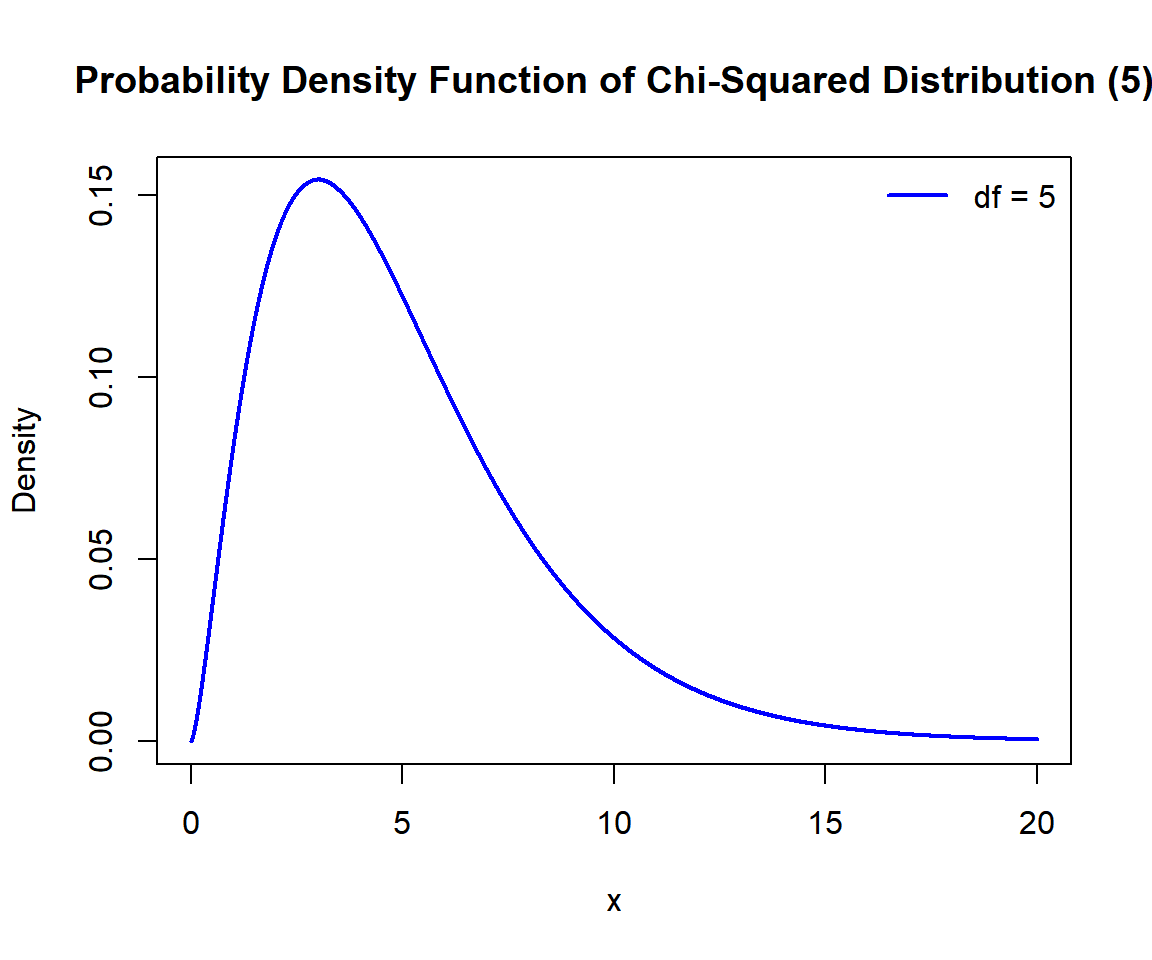
Probability Density Function (PDF) of a Chi-Squared Distribution in R
Multiple distributions:
Below is a plot of multiple chi-squared distribution functions in one graph.
x1 = seq(0, 20, 1/1000); y1 = dchisq(x1, 2)
x2 = seq(0, 20, 1/1000); y2 = dchisq(x2, 5)
x3 = seq(0, 20, 1/1000); y3 = dchisq(x3, 10)
plot(x1, y1, type = "l",
xlim = c(0, 20), ylim = range(c(y1, y2, y3)),
main = "Probability Density Functions of Chi-Squared Distributions",
xlab = "x", ylab = "Density",
lwd = 2, col = "blue")
points(x2, y2, type = "l", lwd = 2, col = "red")
points(x3, y3, type = "l", lwd = 2, col = "green")
# Add legend
legend("topright", c("df = 2",
"df = 5",
"df = 10"),
lwd = c(2, 2, 2),
col = c("blue", "red", "green"),
bty = "n")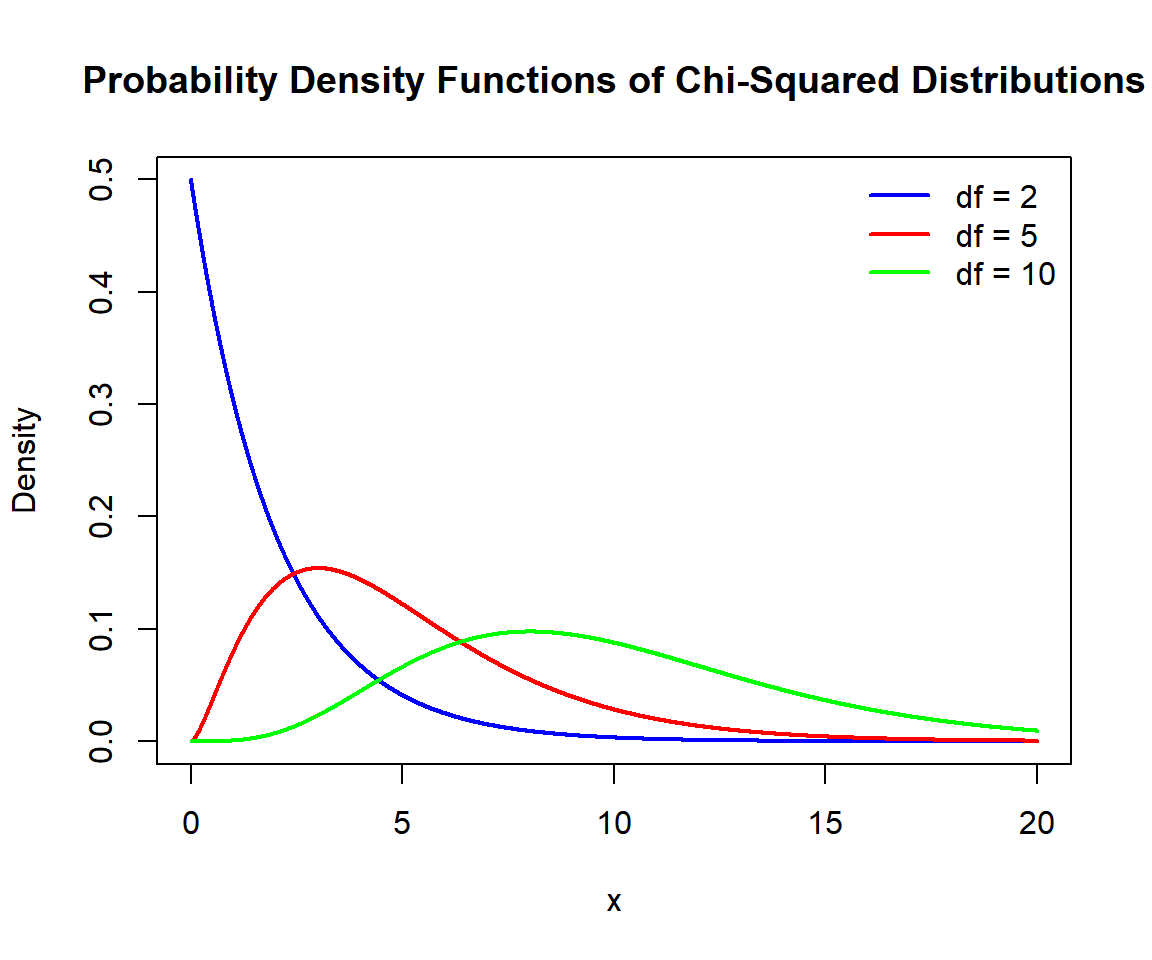
Probability Density Functions (PDFs) of Chi-Squared Distributions in R
3 Examples for Setting Parameters for Chi-Squared Distributions in R
To set the parameter for the chi-squared distribution function, with \(\tt{degrees\;of\;freedom} = 8\).
For example, for dchisq(), the following are the
same:
[1] 0.01088992[1] 0.010889924 rchisq(): Random Sampling from Chi-Squared Distributions in R
Sample 800 observations from the chi-squared distribution with \(\tt{degrees\;of\;freedom} = 6\):
set.seed(1234) # Line allows replication (use any number).
sample = rchisq(800, 6)
hist(sample,
main = "Histogram of 800 Observations from Chi-Squared
Distribution with Degrees of Freedom = 6",
xlab = "x",
col = "deepskyblue", border = "white")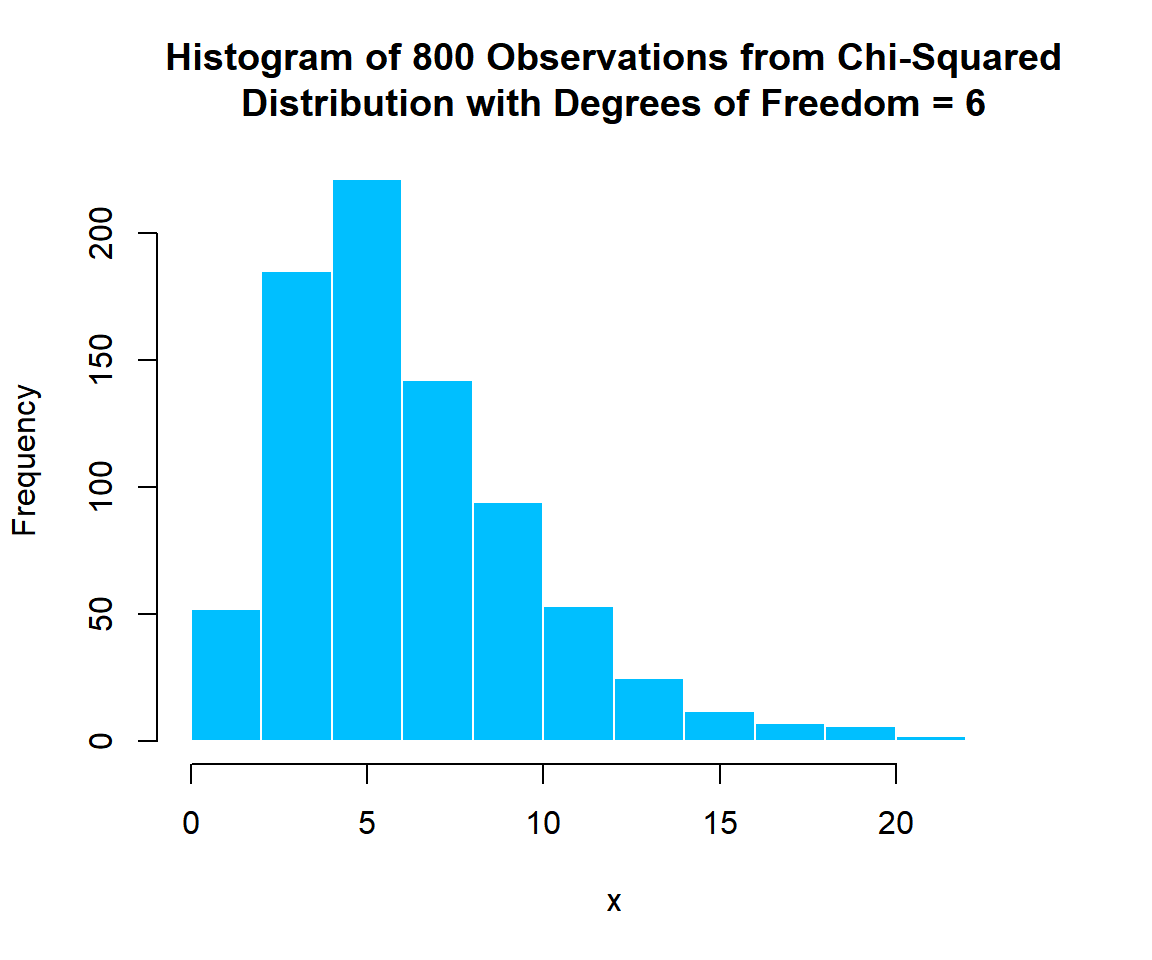
Histogram of Chi-Squared Distribution (6) Random Sample in R
5 dchisq(): Probability Density Function for Chi-Squared Distributions in R
Calculate the density at \(x = 4.5\), in the chi-squared distribution with \(\tt{degrees\;of\;freedom} = 4\):
[1] 0.1185741x = seq(0, 20, 1/1000); y = dchisq(x, 4)
plot(x, y, type = "l",
xlim = c(0, 20), ylim = c(0, max(y)),
main = "Probability Density Function of Chi-Squared
Distribution with Degrees of Freedom = 4",
xlab = "x", ylab = "Density",
lwd = 2, col = "blue")
# Add lines
segments(4.5, -1, 4.5, 0.1185741)
segments(-1, 0.1185741, 4.5, 0.1185741)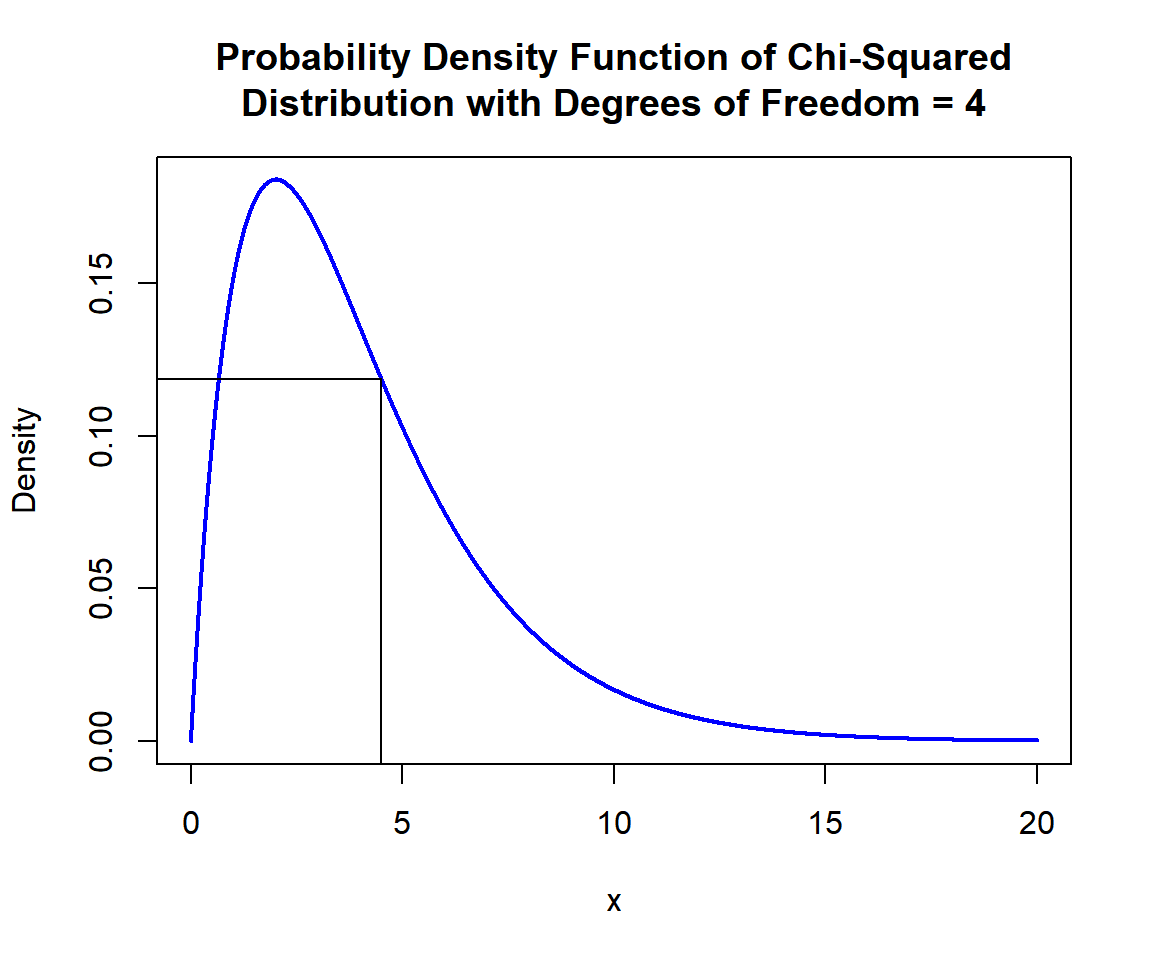
Probability Density Function (PDF) of Chi-Squared Distribution (4) in R
6 pchisq(): Cumulative Distribution Function for Chi-Squared Distributions in R
Calculate the cumulative distribution at \(x = 14.6\), in the chi-squared distribution with \(\tt{degrees\;of\;freedom} = 7\). That is, \(P(X \le 14.6)\):
[1] 0.9585173x = seq(0, 25, 1/1000); y = pchisq(x, 7)
plot(x, y, type = "l",
xlim = c(0, 25), ylim = c(0,1),
main = "Cumulative Distribution Function of Chi-Squared
Distribution with Degrees of Freedom = 7",
xlab = "x", ylab = "Cumulative Distribution",
lwd = 2, col = "blue")
# Add lines
segments(14.6, -1, 14.6, 0.9585173)
segments(-1, 0.9585173, 14.6, 0.9585173)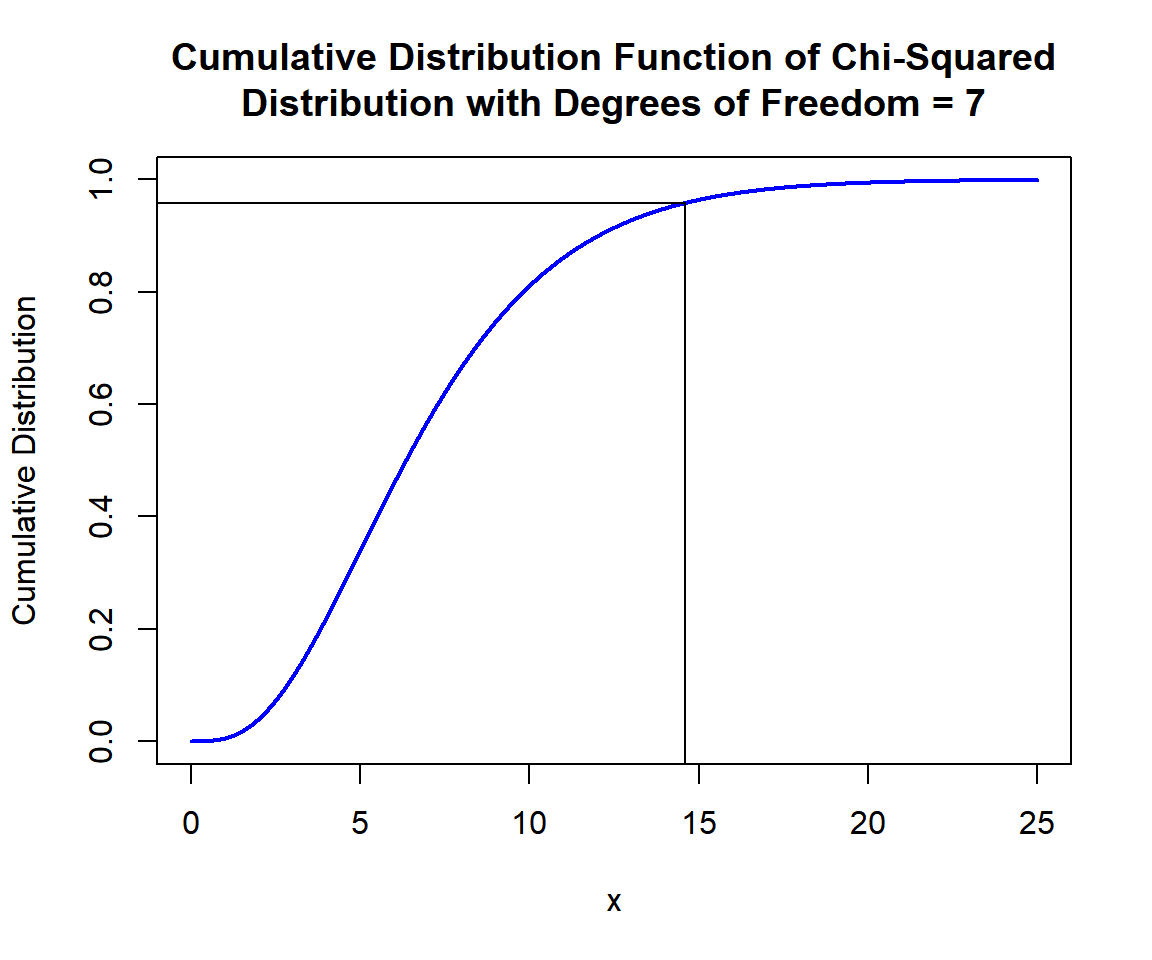
Cumulative Distribution Function (CDF) of Chi-Squared Distribution (7) in R
x = seq(0, 25, 1/1000); y = dchisq(x, 7)
plot(x, y, type = "l",
xlim = c(0, 25), ylim = c(0, max(y)),
main = "Cumulative Distribution Function of Chi-Squared
Distribution with Degrees of Freedom = 7",
xlab = "x", ylab = "Density",
lwd = 2, col = "blue")
# Add shaded region and legend
point = 14.6
polygon(x = c(x[x <= point], point),
y = c(y[x <= point], 0),
col = "limegreen")
legend("topright", c("Area = 0.9585173"),
fill = c("limegreen"),
inset = 0.01)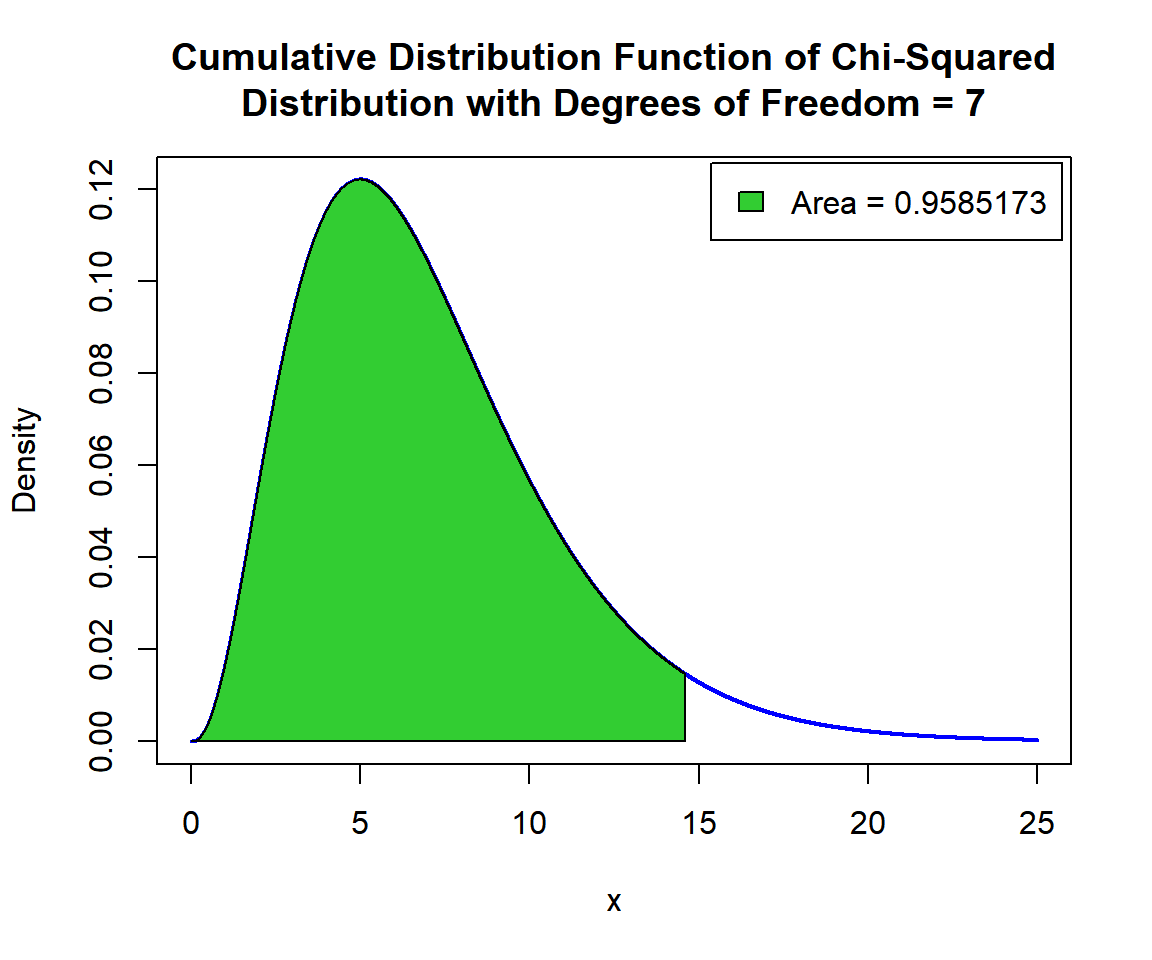
Shaded Probability Density Function (PDF) of Chi-Squared Distribution (7) in R
For upper tail, at \(x = 14.6\), that is, \(P(X \ge 14.6) = 1 - P(X \le 14.6)\), set the "lower.tail" argument:
[1] 0.04148266x = seq(0, 25, 1/1000); y = dchisq(x, 7)
plot(x, y, type = "l",
xlim = c(0, 25), ylim = c(0, max(y)),
main = "Shaded Upper Region: Probability Density Function of
Chi-Squared Distribution with Degrees of Freedom = 7",
xlab = "x", ylab = "Density",
lwd = 2, col = "blue")
# Add shaded region and legend
point = 14.6
polygon(x = c(point, x[x >= point]),
y = c(0, y[x >= point]),
col = "limegreen")
legend("topright", c("Area = 0.04148266"),
fill = c("limegreen"),
inset = 0.01)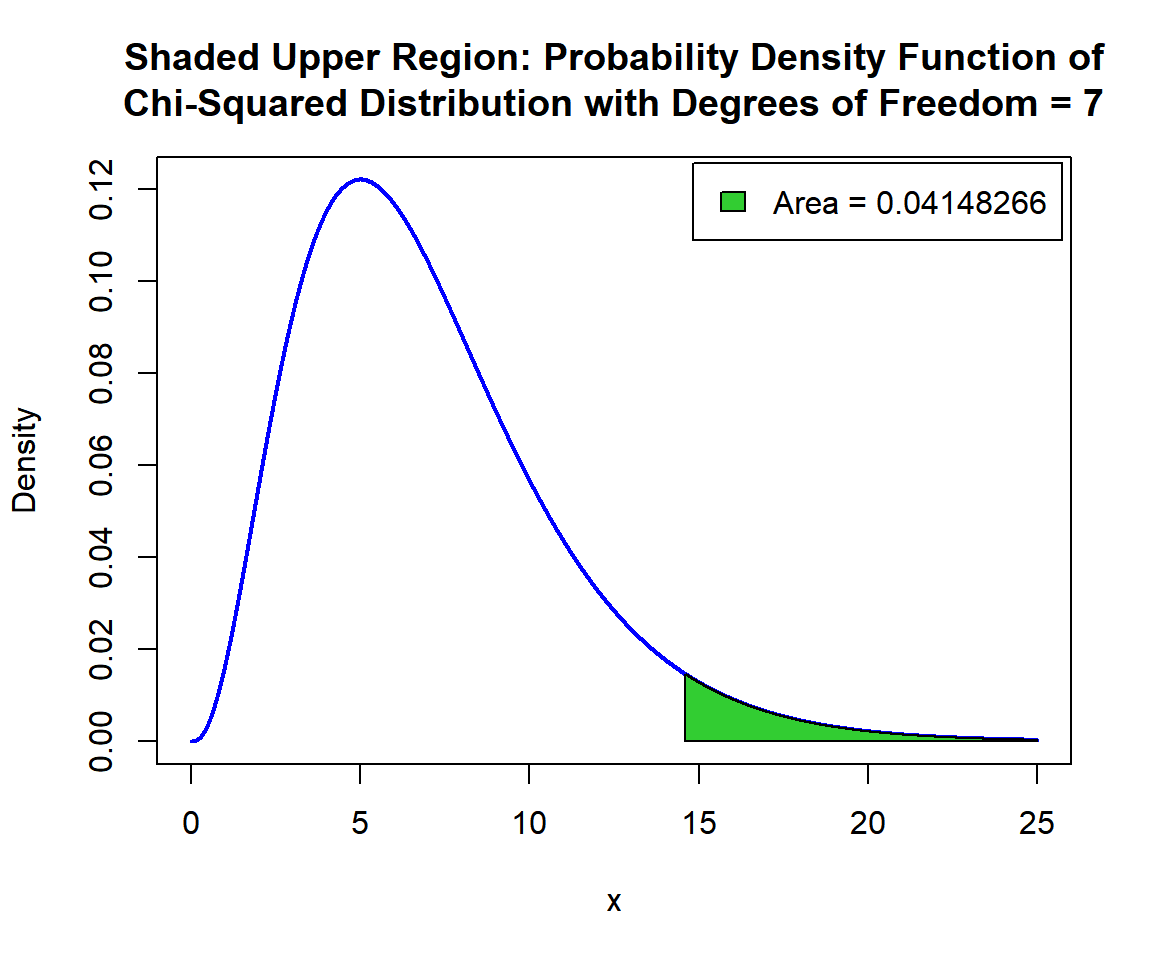
Shaded Upper Region: Probability Density Function (PDF) of Chi-Squared Distribution (7) in R
7 qchisq(): Derive Quantile for Chi-Squared Distributions in R
Derive the quantile for \(p = 0.8\), in the chi-squared distribution with \(\tt{degrees\;of\;freedom} = 3\). That is, \(x\) such that, \(P(X \le x)=0.8\):
[1] 4.641628x = seq(0, 15, 1/1000); y = pchisq(x, 3)
plot(x, y, type = "l",
xlim = c(0, 15), ylim = c(0,1),
main = "Cumulative Distribution Function of Chi-Squared
Distribution with Degrees of Freedom = 3",
xlab = "x", ylab = "Cumulative Distribution",
lwd = 2, col = "blue")
# Add lines
segments(4.641628, -1, 4.641628, 0.8)
segments(-1, 0.8, 4.641628, 0.8)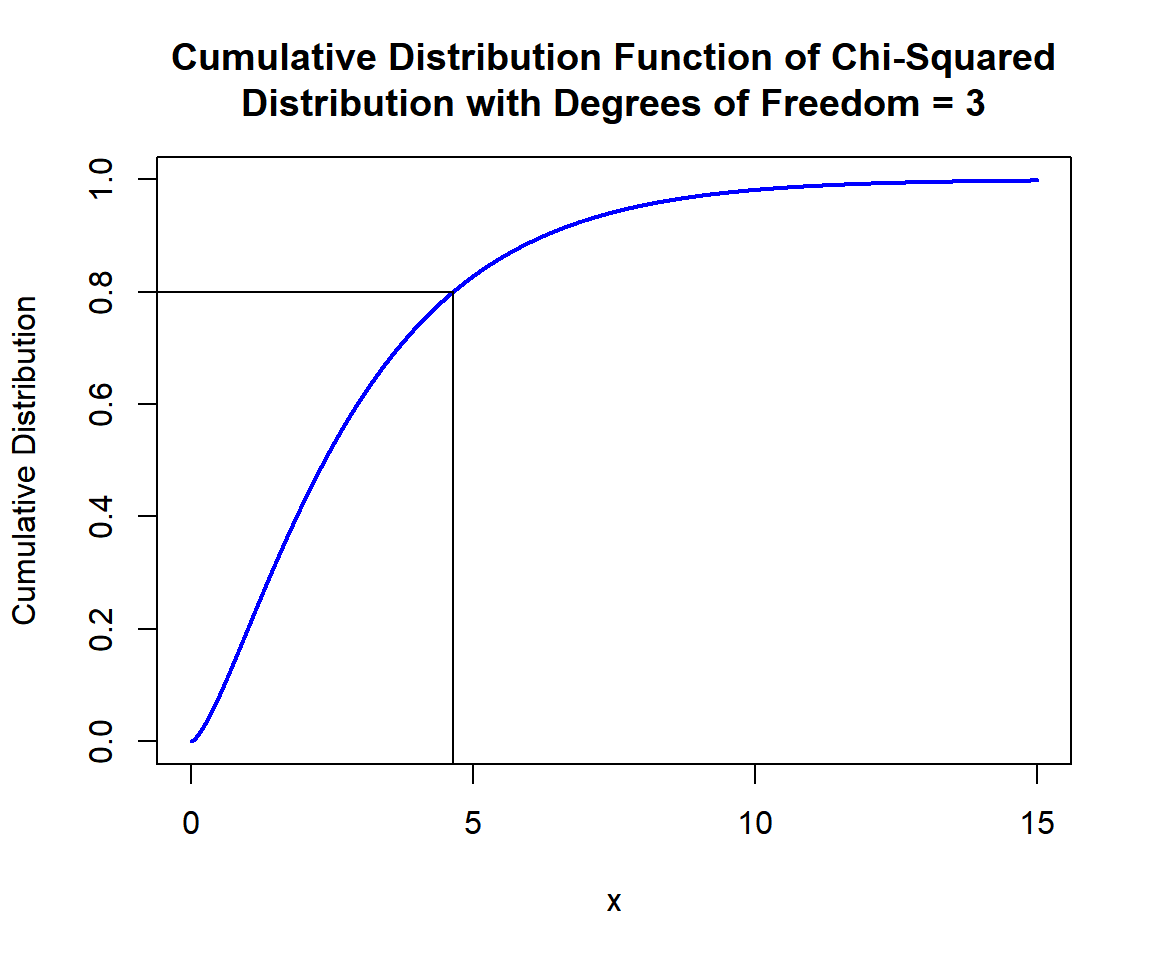
Cumulative Distribution Function (CDF) of Chi-Squared Distribution (3) in R
x = seq(0, 15, 1/1000); y = dchisq(x, 3)
plot(x, y, type = "l",
xlim = c(0, 15), ylim = c(0, max(y)),
main = "Probability Density Function of Chi-Squared
Distribution with Degrees of Freedom = 3",
xlab = "x", ylab = "Density",
lwd = 2, col = "blue")
# Add shaded region and legend
point = 4.641628
polygon(x = c(x[x <= point], point),
y = c(y[x <= point], 0),
col = "limegreen")
legend("topright", c("Area = 0.8"),
fill = c("limegreen"),
inset = 0.01)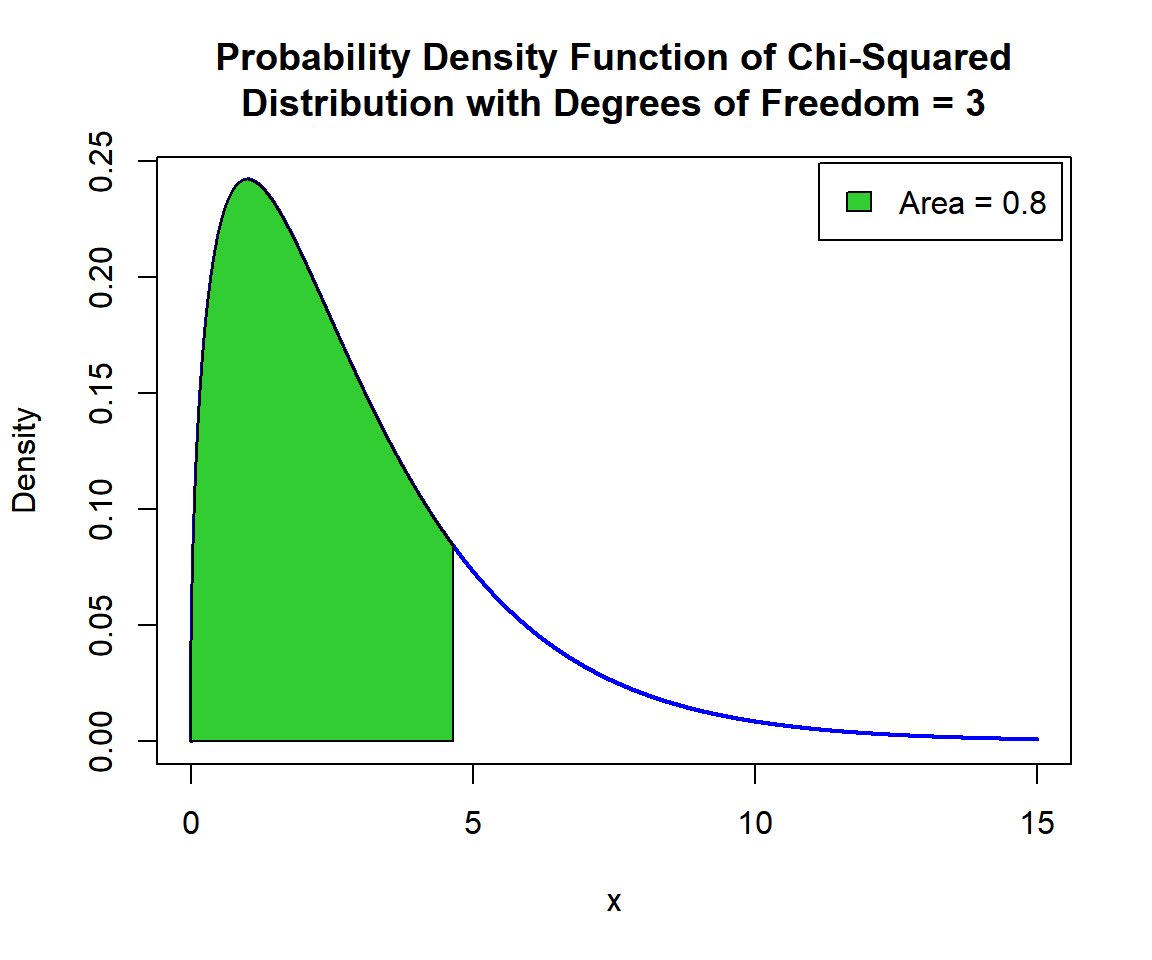
Shaded Probability Density Function (PDF) of Chi-Squared Distribution (3) in R
For upper tail, for \(p = 0.2\), that is, \(x\) such that, \(P(X \ge x)=0.2\):
[1] 4.641628x = seq(0, 15, 1/1000); y = dchisq(x, 3)
plot(x, y, type = "l",
xlim = c(0, 15), ylim = c(0, max(y)),
main = "Shaded Upper Region: Probability Density Function of
Chi-Squared Distribution with Degrees of Freedom = 3",
xlab = "x", ylab = "Density",
lwd = 2, col = "blue")
# Add shaded region and legend
point = 4.641628
polygon(x = c(point, x[x >= point]),
y = c(0, y[x >= point]),
col = "limegreen")
legend("topright", c("Area = 0.2"),
fill = c("limegreen"),
inset = 0.01)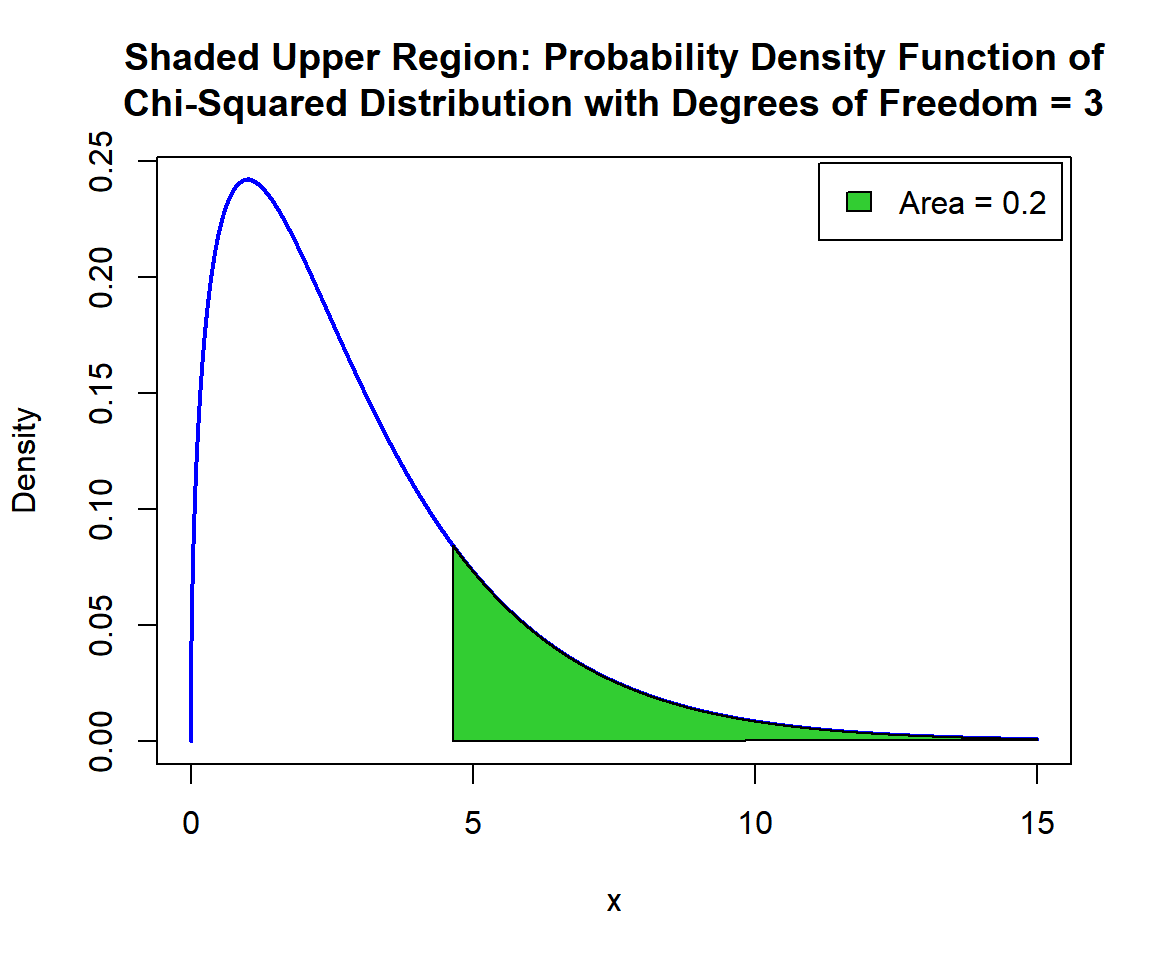
Shaded Upper Region: Probability Density Function (PDF) of Chi-Squared Distribution (3) in R
The feedback form is a Google form but it does not collect any personal information.
Please click on the link below to go to the Google form.
Thank You!
Go to Feedback Form
Copyright © 2020 - 2024. All Rights Reserved by Stats Codes